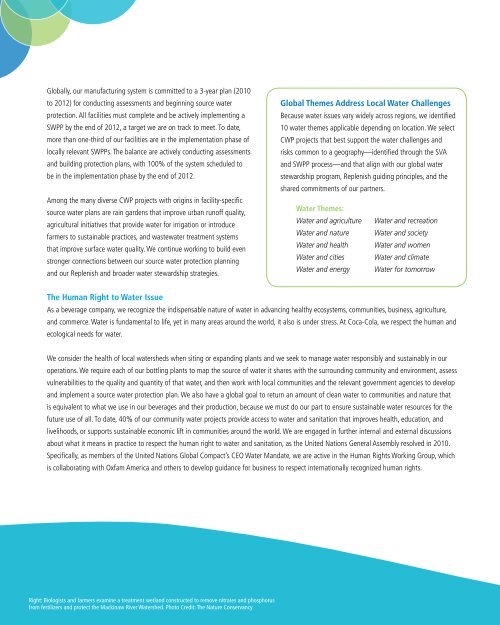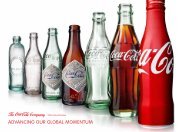Water Stewardship and Replenish Report - Psddev.com
Water Stewardship and Replenish Report - Psddev.com
Water Stewardship and Replenish Report - Psddev.com
You also want an ePaper? Increase the reach of your titles
YUMPU automatically turns print PDFs into web optimized ePapers that Google loves.
Globally, our manufacturing system is <strong>com</strong>mitted to a 3-year plan (2010<br />
to 2012) for conducting assessments <strong>and</strong> beginning source water<br />
protection. All facilities must <strong>com</strong>plete <strong>and</strong> be actively implementing a<br />
SWPP by the end of 2012, a target we are on track to meet. To date,<br />
more than one-third of our facilities are in the implementation phase of<br />
locally relevant SWPPs. The balance are actively conducting assessments<br />
<strong>and</strong> building protection plans, with 100% of the system scheduled to<br />
be in the implementation phase by the end of 2012.<br />
Among the many diverse CWP projects with origins in facility-specific<br />
source water plans are rain gardens that improve urban runoff quality,<br />
agricultural initiatives that provide water for irrigation or introduce<br />
farmers to sustainable practices, <strong>and</strong> wastewater treatment systems<br />
that improve surface water quality. We continue working to build even<br />
stronger connections between our source water protection planning<br />
<strong>and</strong> our <strong>Replenish</strong> <strong>and</strong> broader water stewardship strategies.<br />
Global Themes Address Local <strong>Water</strong> Challenges<br />
Because water issues vary widely across regions, we identified<br />
10 water themes applicable depending on location. We select<br />
CWP projects that best support the water challenges <strong>and</strong><br />
risks <strong>com</strong>mon to a geography—identified through the SVA<br />
<strong>and</strong> SWPP process—<strong>and</strong> that align with our global water<br />
stewardship program, <strong>Replenish</strong> guiding principles, <strong>and</strong> the<br />
shared <strong>com</strong>mitments of our partners.<br />
<strong>Water</strong> Themes:<br />
<strong>Water</strong> <strong>and</strong> agriculture <strong>Water</strong> <strong>and</strong> recreation<br />
<strong>Water</strong> <strong>and</strong> nature <strong>Water</strong> <strong>and</strong> society<br />
<strong>Water</strong> <strong>and</strong> health <strong>Water</strong> <strong>and</strong> women<br />
<strong>Water</strong> <strong>and</strong> cities <strong>Water</strong> <strong>and</strong> climate<br />
<strong>Water</strong> <strong>and</strong> energy <strong>Water</strong> for tomorrow<br />
The Human Right to <strong>Water</strong> Issue<br />
As a beverage <strong>com</strong>pany, we recognize the indispensable nature of water in advancing healthy ecosystems, <strong>com</strong>munities, business, agriculture,<br />
<strong>and</strong> <strong>com</strong>merce. <strong>Water</strong> is fundamental to life, yet in many areas around the world, it also is under stress. At Coca-Cola, we respect the human <strong>and</strong><br />
ecological needs for water.<br />
We consider the health of local watersheds when siting or exp<strong>and</strong>ing plants <strong>and</strong> we seek to manage water responsibly <strong>and</strong> sustainably in our<br />
operations. We require each of our bottling plants to map the source of water it shares with the surrounding <strong>com</strong>munity <strong>and</strong> environment, assess<br />
vulnerabilities to the quality <strong>and</strong> quantity of that water, <strong>and</strong> then work with local <strong>com</strong>munities <strong>and</strong> the relevant government agencies to develop<br />
<strong>and</strong> implement a source water protection plan. We also have a global goal to return an amount of clean water to <strong>com</strong>munities <strong>and</strong> nature that<br />
is equivalent to what we use in our beverages <strong>and</strong> their production, because we must do our part to ensure sustainable water resources for the<br />
future use of all. To date, 40% of our <strong>com</strong>munity water projects provide access to water <strong>and</strong> sanitation that improves health, education, <strong>and</strong><br />
livelihoods, or supports sustainable economic lift in <strong>com</strong>munities around the world. We are engaged in further internal <strong>and</strong> external discussions<br />
about what it means in practice to respect the human right to water <strong>and</strong> sanitation, as the United Nations General Assembly resolved in 2010.<br />
Specifically, as members of the United Nations Global Compact’s CEO <strong>Water</strong> M<strong>and</strong>ate, we are active in the Human Rights Working Group, which<br />
is collaborating with Oxfam America <strong>and</strong> others to develop guidance for business to respect internationally recognized human rights.<br />
Right: Biologists <strong>and</strong> farmers examine a treatment wetl<strong>and</strong> constructed to remove nitrates <strong>and</strong> phosphorus<br />
from fertilizers <strong>and</strong> protect the Mackinaw River <strong>Water</strong>shed. Photo Credit: The Nature Conservancy




